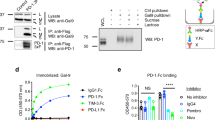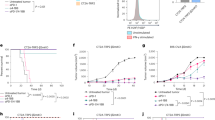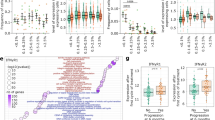Abstract
Tumor-associated ligands of the activating NKG2D receptor can effectively stimulate T cell responses at early but not late stages of tumor growth. In late-stage human tumor settings, we observed MIC-driven proliferation of NKG2D+CD4+ T cells that produced the cytokine Fas ligand (FasL) as a result of NKG2D costimulation but were themselves protected from Fas-mediated growth arrest. In contrast, FasL suppressed proliferation of T cells in vitro that did not receive NKG2D costimulation. Similar observations with normal peripheral blood NKG2D+CD8+ T cells demonstrated unrecognized NKG2D-mediated immune functions, whereby FasL release promotes tumor cell death and NKG2D costimulation prolongs T cell survival. These effects, beneficial in conditions of limited NKG2D ligand expression, may be counterweighed when massive expression and shedding of MIC occurs, such as in some late-stage tumors, that causes sustained NKG2D costimulation and population expansion of immunosuppressive T cells.
This is a preview of subscription content, access via your institution
Access options
Subscribe to this journal
Receive 12 print issues and online access
$209.00 per year
only $17.42 per issue
Buy this article
- Purchase on Springer Link
- Instant access to full article PDF
Prices may be subject to local taxes which are calculated during checkout








Similar content being viewed by others
Change history
20 June 2006
In the version of this article initially published, the key and figure labels for Figure 8c are incorrect. The gray bars are C1R–A2–MICA–M27, the filled bars are C1R–A2–M27, and the cells are CD8+ (not CD4+). The error has been corrected in the HTML and PDF versions of the article.
References
Greenwald, R.J., Freeman, G.J. & Sharpe, A.H. The B7 family revisited. Annu. Rev. Immunol. 23, 515–548 (2005).
Leibson, P.J. The regulation of lymphocyte activation by inhibitory receptors. Curr. Opin. Immunol. 16, 328–336 (2004).
Moser, J.M., Gibbs, J., Jensen, P.E. & Lukacher, A.E. CD94–NKG2A receptors regulate antiviral CD8+ T cell responses. Nat. Immunol. 3, 189–195 (2002).
Roncagalli, R. et al. Negative regulation of natural killer cell function by EAT-2, a SAP-related adaptor. Nat. Immunol. 6, 1002–1010 (2005).
Krueger, A., Fas, S.C., Baumann, S. & Krammer, P.H. The role of CD95 in the regulation of peripheral T-cell apoptosis. Immunol. Rev. 193, 58–69 (2003).
Bosque, A. et al. Human CD8+ T cell blasts are more sensitive than CD4+ T cell blasts to regulation by APO2L/TRAIL. Eur. J. Immunol. 35, 1812–1821 (2005).
Bauer, S. et al. Activation of NK cells and T cells by NKG2D, a receptor for stress-inducible MICA. Science 285, 727–729 (1999).
Groh, V. et al. Costimulation of CD8αβ T cells by NKG2D via engagement by MIC induced on virus-infected cells. Nat. Immunol. 2, 255–260 (2001).
Wu, J. et al. An activating immunoreceptor complex formed by NKG2D and DAP 10. Science 285, 730–732 (1999).
Gonzales, S., Groh, V. & Spies, T. Immunobiology of human NKG2D and its ligands. Curr. Top. Microbiol. Immunol. 298, 121–138 (2006).
Gasser, S., Orsulic, S., Brown, E.J. & Raulet, D.H. The DNA damage pathway regulates innate immune system ligands of the NKG2D receptor. Nature 436, 1186–1190 (2005).
Groh, V., Wu, J., Yee, C. & Spies, T. Tumour-derived soluble MIC ligands impair expression of NKG2D and T cell activation. Nature 419, 734–738 (2002).
Doubrovina, E.S. et al. Evasion from NK cell immunity by MHC class I chain-related molecules expressing colon carcinoma. J. Immunol. 171, 6891–6899 (2003).
Salih, H.R., Rammensee, H-G. & Steinle, A. Down-regulation of MICA on human tumors by proteolytic shedding. J. Immunol. 169, 4098–4102 (2002).
Coudert, J.D. et al. Altered NKG2D function in NK cells induced by chronic exposure to NKG2D ligand-expressing tumor cells. Blood 106, 1711–1717 (2005).
Groh, V., Brühl, A., Nelson, J.L., El-Gabalawi, H. & Spies, T. Stimulation of T cell autoreactivity by anomalous expression of NKG2D and its MIC ligands in rheumatoid arthritis. Proc. Natl. Acad. Sci. USA 100, 9452–9457 (2003).
Sallustro, F., Lenig, D., Forster, R., Lipp, M. & Lanzavecchia, A. Two subsets of memory T lymphocytes with distinct homing potentials and effector functions. Nature 401, 708–712 (1999).
Rosen, D.B. et al. A structural basis for the association of DAP12 with mouse, but not human, NKG2D. J. Immunol. 173, 2470–2478 (2004).
Steinle, A. et al. Interactions of human NKG2D with its ligands MICA, MICB, and homologs of the mouse RAE-1 protein family. Immunogenetics 53, 279–287 (2001).
Koopman, G. et al. Annexin V for flow cytometric detection of phosphatidylserine expression on B cells undergoing apoptosis. Blood 84, 1415–1420 (1994).
Levings, M.K. & Roncarolo, M.G. Phenotypic and functional differences between human CD4+CD25+ and type 1 regulatory T cells. Curr. Top. Microbiol. Immunol. 293, 303–326 (2005).
Gavin, M. & Rudensky, A. Control of immune homeostasis by naturally arising regulatory CD4+ T cells. Curr. Opin. Immunol. 15, 690–696 (2003).
Roncarolo, M.G., Bacchetta, R., Bordignon, C., Narula, S. & Levings, M.K. Type 1 T regulatory cells. Immunol. Rev. 182, 68–79 (2001).
Groh, V. et al. Efficient cross-priming of tumor antigen-specific T cells by dendritic cells sensitized with diverse anti-MICA opsonized tumor cells. Proc. Natl. Acad. Sci. USA 102, 6461–6466 (2005).
Ebert, E.C. Interleukin-12 up-regulates perforin- and Fas-mediated lymphokine-activated killer activity by intestinal intraepithelial lymphocytes. Clin. Exp. Immunol. 138, 259–265 (2004).
Maccalli, C. et al. NKG2D engagement of colorectal cancer-specific T cells strengthens TCR-mediated antigen stimulation and elicits TCR-independent anti-tumor activity. Eur. J. Immunol. 33, 2033–2043 (2003).
Meresse, B. et al. Coordinated induction by IL-15 of a TCR-independent pathway converts CTL into lymphokine-activated killer cells in celiac disease. Immunity 21, 357–366 (2004).
Bacchetta, R. et al. Growth and expansion of human T regulatory type 1 cells are independent from TCR activation but require exogenous cytokines. Eur. J. Immunol. 32, 2237–2245 (2002).
Poggi, A., Massaro, A-M., Negrini, S., Contini, P. & Zochi, M.R. Tumor-induced apoptosis of human IL-2-activated NK cells: Role of natural cytotoxicity receptors. J. Immunol. 174, 2653–2660 (2005).
Poggi, A. et al. Regulation of γδ T cell survival by soluble HLA-I: Involvement of CD8 and activating killer Ig-like receptors. Eur. J. Immunol. 35, 2670–2678 (2005).
Kirchhoff, S., Müller, W.W., Li-Weber, M. & Krammer, P.H. Up-regulation of c-FLIPshort and reduction of activation-induced cell death in CD28-costimulated human T cells. Eur. J. Immunol. 30, 2765–2774 (2000).
Boise, L.H. et al. CD28 costimulation can promote T cell survival by enhancing the expression of Bcl-XL . Immunity 3, 87–98 (1995).
Kriegeskorte, A.K. et al. NKG2D-independent suppression of T cell proliferation by H60 and MICA. Proc. Natl. Acad. Sci. USA 102, 11805–11810 (2005).
Groh, V., Steinle, A., Bauer, S. & Spies, T. Recognition of stress-induced MHC molecules by intestinal epithelial γδ T cells. Science 279, 1737–1740 (1998).
Li, Y., Bleakley, M. & Yee, C. IL-21 influences the frequency, phenotype, and affinity of the antigen-specific CD8 T cell response. J. Immunol. 175, 2261–2269 (2005).
Roncador, G. et al. Analysis of FOXP3 protein expression in human CD4+CD25+ regulatory T cells at the single-cell level. Eur. J. Immunol. 35, 1681–1691 (2005).
Wu, J., Groh, V. & Spies, T. T cell antigen receptor engagement and specificity in the recognition of stress-inducible MIC by human epithelial γδ T cells. J. Immunol. 169, 1236–1240 (2002).
Acknowledgements
We thank G. Venkataraman for help with real-time PCR, and C. Yee for T cell clones. Supported by the Avon Foundation Breast Cancer Immunotherapy Research Initiative and the National Institutes of Health (AI30581 and AI52319).
Author information
Authors and Affiliations
Corresponding authors
Ethics declarations
Competing interests
The authors declare no competing financial interests.
Supplementary information
Supplementary Fig. 1
Frequency distributions of NKG2D+CD4+ T cells. (PDF 448 kb)
Supplementary Fig. 2
Expression of CD25, CD45RO and HLA-DR by NKG2D+CD4+ T (PDF 176 kb)
Rights and permissions
About this article
Cite this article
Groh, V., Smythe, K., Dai, Z. et al. Fas ligand–mediated paracrine T cell regulation by the receptor NKG2D in tumor immunity. Nat Immunol 7, 755–762 (2006). https://doi.org/10.1038/ni1350
Received:
Accepted:
Published:
Issue Date:
DOI: https://doi.org/10.1038/ni1350
This article is cited by
-
Rolle von angeborenen Rezeptoren bei chronischen Entzündungen und Autoimmunität
Zeitschrift für Rheumatologie (2022)
-
Increased regulatory B cells are involved in immune evasion in patients with gastric cancer
Scientific Reports (2019)
-
Regulatory NK1.1−CD4+NKG2D+ subset induced by NKG2DL+ cells promotes tumor evasion in mice
Cancer Immunology, Immunotherapy (2018)
-
Human fused NKG2D–IL-15 protein controls xenografted human gastric cancer through the recruitment and activation of NK cells
Cellular & Molecular Immunology (2017)
-
Correlation of serum MMP3 and other biomarkers with clinical outcomes in patients with ankylosing spondylitis: a pilot study
Clinical Rheumatology (2017)



